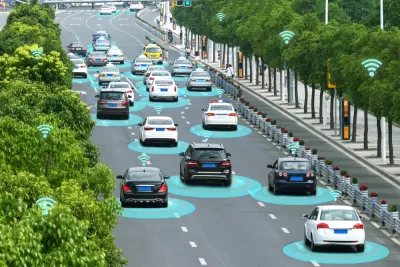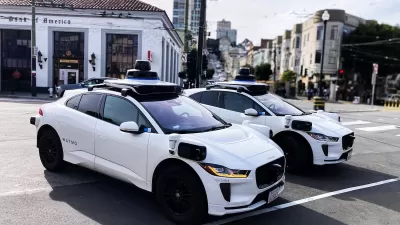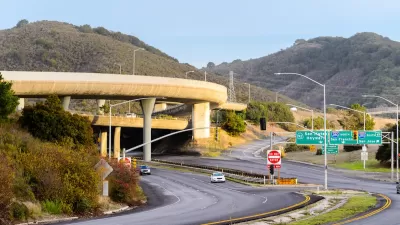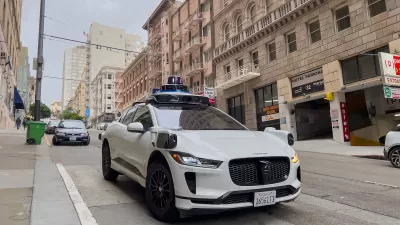When cars first started proliferating on American roads, it led to increased sprawl and flight from central cities. What can we do now to prevent the same problem as AVs become more widespread?

According to a new study, autonomous vehicles "unleash a second wave of suburban sprawl that makes cities inhospitable to people outside cars in new ways — unless governments adopt policies to soften their impact now," reports Kea Wilson. Such policies could, in fact, "also curb the worst impacts of manual car dependency."
When technology researcher Carlos Ignacio Gutierrez took on the question of "what the rise of robocars might mean for land use, city revenues, and the ways that people live outside their automobiles," he used historical data to evaluate what could happen as AVs gain prominence on American roads. According to Gutierrez, widespread use of autonomous vehicles, especially "if cities decide to focus on shared options — or at least very cheap ones," could drive mega-sprawl and "create flight incentives" in the same way that the proliferation of cars in the early 20th century drove many–especially white–Americans to the suburbs.
As commutes to central cities became faster and more convenient("at least until the highways started to clog"), people fled to the periphery. "They wanted a larger home, they wanted a better ambiance for their families, and the government incentivized them to get those things cheaply." Meanwhile, low-income households of color "were largely redlined out of that suburban exodus and concentrated into over-policed and under-resourced neighborhoods."
Gutierrez recommends ways that cities can get ahead of this second looming 'carpocalypse.'
Getting rid of parking minimums now and allowing developers to redevelop existing parking, for instance, is a smart way to prepare for a future where a small number of driverless vehicles circle the city and only stop to pick up their passengers now and then. Implementing congestion charges, cordon tolls, and other pricing schemes that disincentivize driving between cities and suburbs can help, too — especially if the autono-bus gets a break on the fees.
"[E]ven good old-fashioned zoning reform" could increase the supply of '15-minute neighborhoods' and "encourage residents to stay put in dense areas, rather than zipping away in their driverless vehicles to parts unknown." These simple strategies, according to Gutierrez, should be implemented now, before robocars take over the road. If cities take steps to build out "strong public transportation infrastructure," says Gutierrez, society could "benefit enormously" from autonomous vehicles.
FULL STORY: What Would Our Cities Look Like If AVs Ruled the Roads?

Study: Maui’s Plan to Convert Vacation Rentals to Long-Term Housing Could Cause Nearly $1 Billion Economic Loss
The plan would reduce visitor accommodation by 25,% resulting in 1,900 jobs lost.

North Texas Transit Leaders Tout Benefits of TOD for Growing Region
At a summit focused on transit-oriented development, policymakers discussed how North Texas’ expanded light rail system can serve as a tool for economic growth.

Why Should We Subsidize Public Transportation?
Many public transit agencies face financial stress due to rising costs, declining fare revenue, and declining subsidies. Transit advocates must provide a strong business case for increasing public transit funding.

How to Make US Trains Faster
Changes to boarding platforms and a switch to electric trains could improve U.S. passenger rail service without the added cost of high-speed rail.

Columbia’s Revitalized ‘Loop’ Is a Hub for Local Entrepreneurs
A focus on small businesses is helping a commercial corridor in Columbia, Missouri thrive.

Invasive Insect Threatens Minnesota’s Ash Forests
The Emerald Ash Borer is a rapidly spreading invasive pest threatening Minnesota’s ash trees, and homeowners are encouraged to plant diverse replacement species, avoid moving ash firewood, and monitor for signs of infestation.
Urban Design for Planners 1: Software Tools
This six-course series explores essential urban design concepts using open source software and equips planners with the tools they need to participate fully in the urban design process.
Planning for Universal Design
Learn the tools for implementing Universal Design in planning regulations.
City of Santa Clarita
Ascent Environmental
Institute for Housing and Urban Development Studies (IHS)
City of Grandview
Harvard GSD Executive Education
Toledo-Lucas County Plan Commissions
Salt Lake City
NYU Wagner Graduate School of Public Service





























